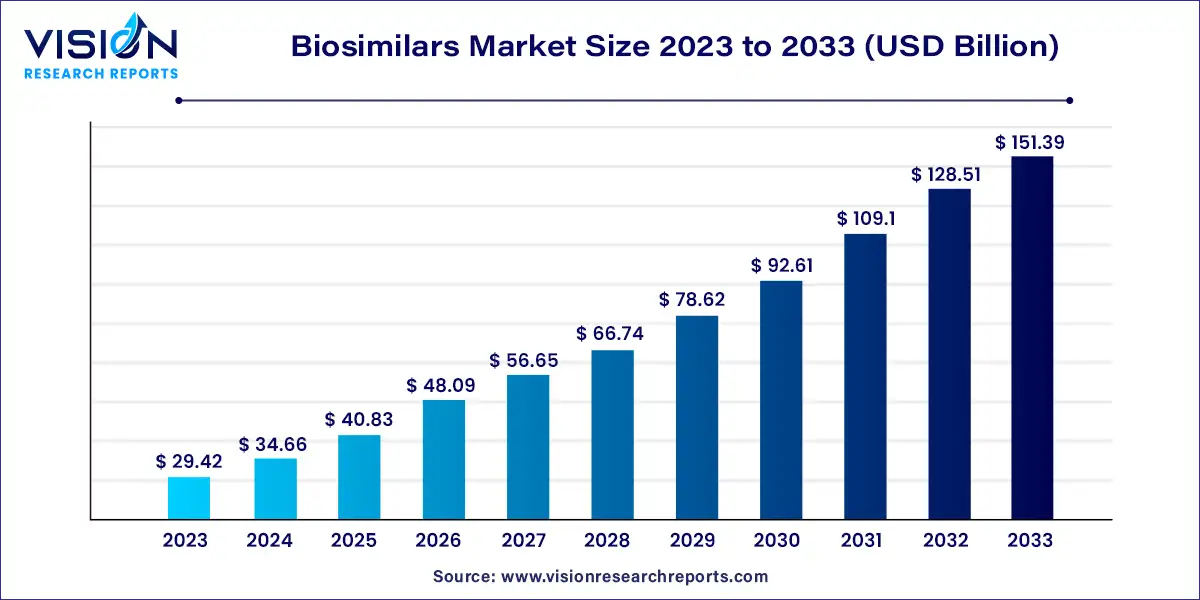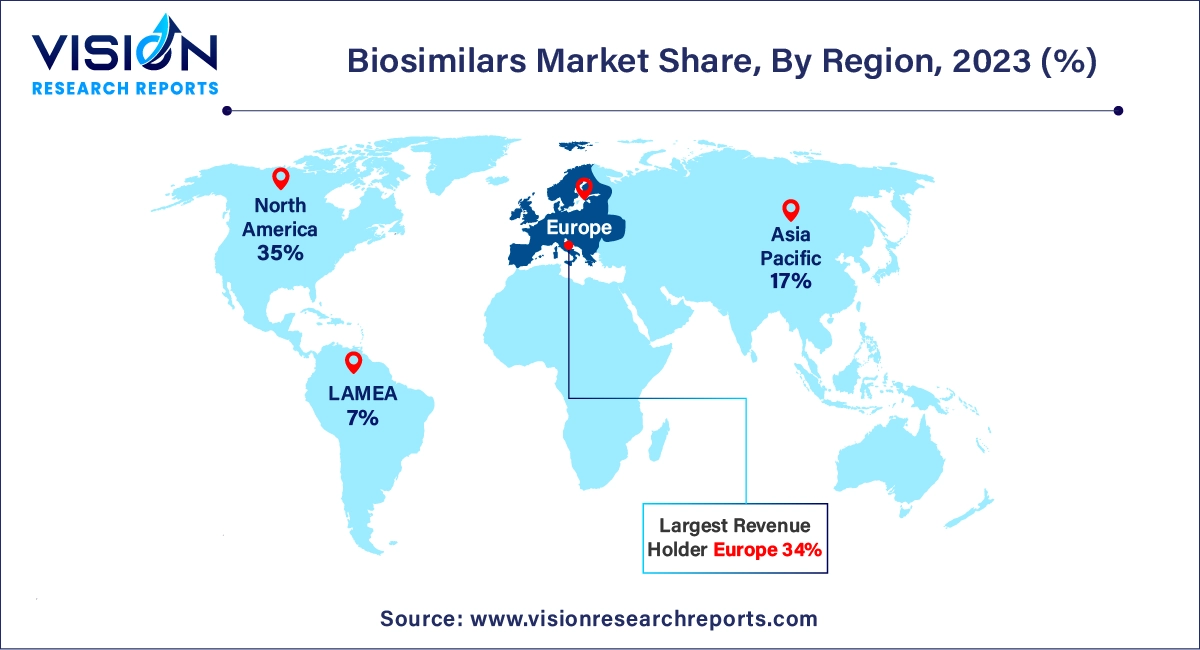The global biosimilars market size was valued at USD 29.42 billion in 2023 and it is predicted to surpass around USD 151.39 billion by 2033 with a CAGR of 17.8% from 2024 to 2033. The biosimilars market is experiencing significant growth, driven by advancements in biotechnology and increasing healthcare needs. Biosimilars, which are highly similar to approved reference biologics, offer a cost-effective alternative and are becoming a crucial component of global healthcare strategies.

The biosimilars market is witnessing robust growth driven by the demand for cost-effective healthcare solutions, as biosimilars offer significant savings compared to their reference biologics. This cost advantage is particularly important in addressing the escalating global healthcare expenses. Additionally, the growing prevalence of chronic diseases such as cancer and diabetes fuels the need for biologic treatments, and as patents for major biologics expire, biosimilars provide a viable alternative. The supportive regulatory environment further accelerates market expansion, with regulatory agencies streamlining the approval processes for biosimilars. Advances in biotechnology and manufacturing techniques also contribute to the market's growth by enhancing the quality and production efficiency of biosimilars. Together, these factors create a favorable landscape for the continued expansion of the biosimilars market.
In 2023, Europe led the global market with the largest market share of 34% and is projected to maintain its leading position throughout the forecast period. This dominance is attributed to the increased adoption of biosimilars across the region and the proactive role of regulatory authorities. European regulators have implemented favorable changes to facilitate the approval of biosimilar drugs, further supporting market growth.

North America is expected to experience substantial growth during the forecast period. The growing acceptance of biosimilars and significant investments by numerous market players in research and development are anticipated to drive this growth. In 2020, the FDA approved around 20 biosimilars, including Pfizer’s Nyvepria, aimed at reducing infection rates. These developments are expected to boost the biosimilars market in North America.
In 2023, the monoclonal antibodies segment captured the largest revenue share. These antibodies are widely used for treating conditions such as cancer, rheumatoid arthritis, cardiovascular diseases, and multiple sclerosis. Their ability to target specific infected cells makes them particularly effective in cancer treatment, solidifying their position as the leading segment in the market.
The erythropoietin segment is anticipated to grow the fastest during the forecast period. Erythropoietin is crucial for stimulating red blood cell production in the bone marrow and is effective in treating anemia. The increasing incidence of kidney-related diseases is expected to drive growth in this segment.
The oncology segment was the largest revenue generator in the global biosimilars market in 2023 and is expected to continue leading throughout the forecast period. This dominance is due to the affordability of biosimilars for cancer treatment and the rising global incidence of cancer. According to the International Agency for Research on Cancer, there were approximately 19.3 million new cancer cases and 10 million cancer-related deaths globally in 2020. The prevalence of breast cancer, which accounted for 11.7% of new cases, followed by lung cancer at 11.4% and colorectal cancer at 10.0%, underscores the growing demand for biosimilars in oncology.
On the other hand, the growth hormonal deficiency segment is projected to be the fastest-growing. The increasing incidence of growth hormone deficiencies in children, with a reported 50% chance during pregnancy according to the National Organization for Rare Disorders, is expected to drive this segment’s growth.
By Product
By Application
By Manufacturer
By Region
Chapter 1. Introduction
1.1. Research Objective
1.2. Scope of the Study
1.3. Definition
Chapter 2. Research Methodology
2.1. Research Approach
2.2. Data Sources
2.3. Assumptions & Limitations
Chapter 3. Executive Summary
3.1. Market Snapshot
Chapter 4. Market Variables and Scope
4.1. Introduction
4.2. Market Classification and Scope
4.3. Industry Value Chain Analysis
4.3.1. Raw Material Procurement Analysis
4.3.2. Sales and Distribution Product Analysis
4.3.3. Downstream Buyer Analysis
Chapter 5. COVID 19 Impact on Biosimilars Market
5.1. COVID-19 Landscape: Biosimilars Industry Impact
5.2. COVID 19 - Impact Assessment for the Industry
5.3. COVID 19 Impact: Global Major Government Policy
5.4. Market Trends and Opportunities in the COVID-19 Landscape
Chapter 6. Market Dynamics Analysis and Trends
6.1. Market Dynamics
6.1.1. Market Drivers
6.1.2. Market Restraints
6.1.3. Market Opportunities
6.2. Porter’s Five Forces Analysis
6.2.1. Bargaining power of suppliers
6.2.2. Bargaining power of buyers
6.2.3. Threat of substitute
6.2.4. Threat of new entrants
6.2.5. Degree of competition
Chapter 7. Competitive Landscape
7.1.1. Company Market Share/Positioning Analysis
7.1.2. Key Strategies Adopted by Players
7.1.3. Vendor Landscape
7.1.3.1. List of Suppliers
7.1.3.2. List of Buyers
Chapter 8. Global Biosimilars Market, By Product
8.1. Biosimilars Market, by Product
8.1.1 Monoclonal Antibodies
8.1.1.1. Market Revenue and Forecast
8.1.2. Somatropin
8.1.2.1. Market Revenue and Forecast
8.1.3. Insulin
8.1.3.1. Market Revenue and Forecast
8.1.4. Erythropoietin
8.1.4.1. Market Revenue and Forecast
8.1.5. Follitropin
8.1.5.1. Market Revenue and Forecast
8.1.6. Others
8.1.6.1. Market Revenue and Forecast
Chapter 9. Global Biosimilars Market, By Application
9.1. Biosimilars Market, by Application
9.1.1. Oncology
9.1.1.1. Market Revenue and Forecast
9.1.2. Growth Hormonal Deficiency
9.1.2.1. Market Revenue and Forecast
9.1.3. Blood Disorders
9.1.3.1. Market Revenue and Forecast
9.1.4. Chronic & Autoimmune Disorders
9.1.4.1. Market Revenue and Forecast
9.1.5. Infectious Disease
9.1.5.1. Market Revenue and Forecast
Chapter 10. Global Biosimilars Market, By Manufacturer
10.1. Biosimilars Market, by Manufacturer
10.1.1. Contract Research and Manufacturing Services
10.1.1.1. Market Revenue and Forecast
10.1.2. In-house
10.1.2.1. Market Revenue and Forecast
Chapter 11. Global Biosimilars Market, Regional Estimates and Trend Forecast
11.1. North America
11.1.1. Market Revenue and Forecast, by Product
11.1.2. Market Revenue and Forecast, by Application
11.1.3. Market Revenue and Forecast, by Manufacturer
11.1.4. U.S.
11.1.4.1. Market Revenue and Forecast, by Product
11.1.4.2. Market Revenue and Forecast, by Application
11.1.4.3. Market Revenue and Forecast, by Manufacturer
11.1.5. Rest of North America
11.1.5.1. Market Revenue and Forecast, by Product
11.1.5.2. Market Revenue and Forecast, by Application
11.1.5.3. Market Revenue and Forecast, by Manufacturer
11.2. Europe
11.2.1. Market Revenue and Forecast, by Product
11.2.2. Market Revenue and Forecast, by Application
11.2.3. Market Revenue and Forecast, by Manufacturer
11.2.4. UK
11.2.4.1. Market Revenue and Forecast, by Product
11.2.4.2. Market Revenue and Forecast, by Application
11.2.4.3. Market Revenue and Forecast, by Manufacturer
11.2.5. Germany
11.2.5.1. Market Revenue and Forecast, by Product
11.2.5.2. Market Revenue and Forecast, by Application
11.2.5.3. Market Revenue and Forecast, by Manufacturer
11.2.6. France
11.2.6.1. Market Revenue and Forecast, by Product
11.2.6.2. Market Revenue and Forecast, by Application
11.2.6.3. Market Revenue and Forecast, by Manufacturer
11.2.7. Rest of Europe
11.2.7.1. Market Revenue and Forecast, by Product
11.2.7.2. Market Revenue and Forecast, by Application
11.2.7.3. Market Revenue and Forecast, by Manufacturer
11.3. APAC
11.3.1. Market Revenue and Forecast, by Product
11.3.2. Market Revenue and Forecast, by Application
11.3.3. Market Revenue and Forecast, by Manufacturer
11.3.4. India
11.3.4.1. Market Revenue and Forecast, by Product
11.3.4.2. Market Revenue and Forecast, by Application
11.3.4.3. Market Revenue and Forecast, by Manufacturer
11.3.5. China
11.3.5.1. Market Revenue and Forecast, by Product
11.3.5.2. Market Revenue and Forecast, by Application
11.3.5.3. Market Revenue and Forecast, by Manufacturer
11.3.6. Japan
11.3.6.1. Market Revenue and Forecast, by Product
11.3.6.2. Market Revenue and Forecast, by Application
11.3.6.3. Market Revenue and Forecast, by Manufacturer
11.3.7. Rest of APAC
11.3.7.1. Market Revenue and Forecast, by Product
11.3.7.2. Market Revenue and Forecast, by Application
11.3.7.3. Market Revenue and Forecast, by Manufacturer
11.4. MEA
11.4.1. Market Revenue and Forecast, by Product
11.4.2. Market Revenue and Forecast, by Application
11.4.3. Market Revenue and Forecast, by Manufacturer
11.4.4. GCC
11.4.4.1. Market Revenue and Forecast, by Product
11.4.4.2. Market Revenue and Forecast, by Application
11.4.4.3. Market Revenue and Forecast, by Manufacturer
11.4.5. North Africa
11.4.5.1. Market Revenue and Forecast, by Product
11.4.5.2. Market Revenue and Forecast, by Application
11.4.5.3. Market Revenue and Forecast, by Manufacturer
11.4.6. South Africa
11.4.6.1. Market Revenue and Forecast, by Product
11.4.6.2. Market Revenue and Forecast, by Application
11.4.6.3. Market Revenue and Forecast, by Manufacturer
11.4.7. Rest of MEA
11.4.7.1. Market Revenue and Forecast, by Product
11.4.7.2. Market Revenue and Forecast, by Application
11.4.7.3. Market Revenue and Forecast, by Manufacturer
11.5. Latin America
11.5.1. Market Revenue and Forecast, by Product
11.5.2. Market Revenue and Forecast, by Application
11.5.3. Market Revenue and Forecast, by Manufacturer
11.5.4. Brazil
11.5.4.1. Market Revenue and Forecast, by Product
11.5.4.2. Market Revenue and Forecast, by Application
11.5.4.3. Market Revenue and Forecast, by Manufacturer
11.5.5. Rest of LATAM
11.5.5.1. Market Revenue and Forecast, by Product
11.5.5.2. Market Revenue and Forecast, by Application
11.5.5.3. Market Revenue and Forecast, by Manufacturer
Chapter 12. Company Profiles
12.1. Novartis.
12.1.1. Company Overview
12.1.2. Product Offerings
12.1.3. Financial Performance
12.1.4. Recent Initiatives
12.2. Synthon Pharmaceuticals, Inc.
12.2.1. Company Overview
12.2.2. Product Offerings
12.2.3. Financial Performance
12.2.4. Recent Initiatives
12.3. TevaPharmaceutical Industries Ltd.
12.3.1. Company Overview
12.3.2. Product Offerings
12.3.3. Financial Performance
12.3.4. Recent Initiatives
12.4. LG Life Sciences.
12.4.1. Company Overview
12.4.2. Product Offerings
12.4.3. Financial Performance
12.4.4. Recent Initiatives
12.5. Celltrion.
12.5.1. Company Overview
12.5.2. Product Offerings
12.5.3. Financial Performance
12.5.4. Recent Initiatives
12.6. Biocon
12.6.1. Company Overview
12.6.2. Product Offerings
12.6.3. Financial Performance
12.6.4. Recent Initiatives
12.7. Hospira.
12.7.1. Company Overview
12.7.2. Product Offerings
12.7.3. Financial Performance
12.7.4. Recent Initiatives
12.8. Merck Serono
12.8.1. Company Overview
12.8.2. Product Offerings
12.8.3. Financial Performance
12.8.4. Recent Initiatives
12.9. Biogen idec, Inc.
12.9.1. Company Overview
12.9.2. Product Offerings
12.9.3. Financial Performance
12.9.4. Recent Initiatives
12.10. Genentech
12.10.1. Company Overview
12.10.2. Product Offerings
12.10.3. Financial Performance
12.10.4. Recent Initiatives
Chapter 13. Research Methodology
13.1. Primary Research
13.2. Secondary Research
13.3. Assumptions
Chapter 14. Appendix
14.1. About Us
14.2. Glossary of Terms
 Cross-segment Market Size and Analysis for
Mentioned Segments
Cross-segment Market Size and Analysis for
Mentioned Segments
 Additional Company Profiles (Upto 5 With No Cost)
Additional Company Profiles (Upto 5 With No Cost)
 Additional Countries (Apart From Mentioned Countries)
Additional Countries (Apart From Mentioned Countries)
 Country/Region-specific Report
Country/Region-specific Report
 Go To Market Strategy
Go To Market Strategy
 Region Specific Market Dynamics
Region Specific Market Dynamics Region Level Market Share
Region Level Market Share Import Export Analysis
Import Export Analysis Production Analysis
Production Analysis Others
Others